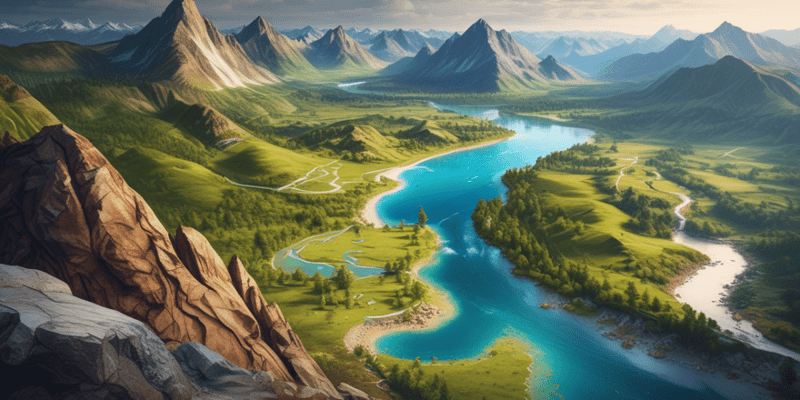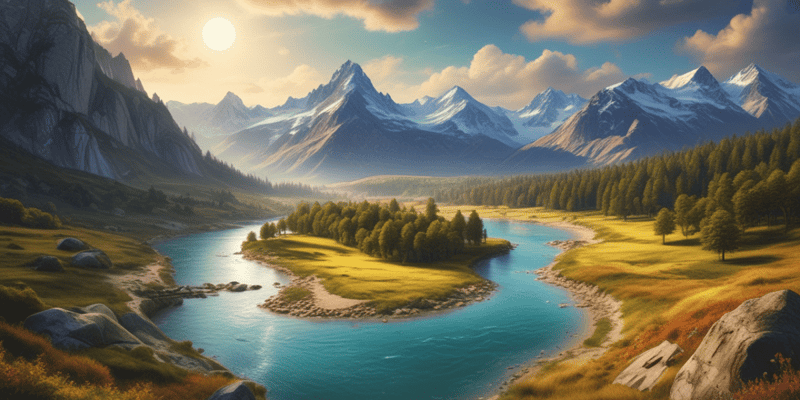Podcast Beta
Questions and Answers
What type of mountains are formed from lava or debris ejected from a volcano?
Which type of mountain is typically formed at convergent boundaries where continents collide?
What is the defining characteristic of fault-block mountains?
Which of the following is an example of a fault-block mountain range?
Signup and view all the answers
How are folded mountains primarily formed?
Signup and view all the answers
What distinguishes plateaus from plains?
Signup and view all the answers
Which of these mountains is known as a volcanic mountain?
Signup and view all the answers
What factors contribute to the formation of plains?
Signup and view all the answers
What is the primary criterion for a landform to be classified as a mountain?
Signup and view all the answers
What term is used to describe a group of mountains sharing similar shape and structure?
Signup and view all the answers
What are the two main mountain belts recognized by some scientists?
Signup and view all the answers
What causes mountains to form over time?
Signup and view all the answers
Why are some mountains referred to as 'young'?
Signup and view all the answers
How do mountains change as they age?
Signup and view all the answers
What describes 'old' mountains?
Signup and view all the answers
On what basis are mountains classified?
Signup and view all the answers
Study Notes
What are Mountains?
- A landform with a high elevation
- For a hill or mound to be classified as a mountain, its summit must be higher than a few hundred meters above the surrounding land.
- Example: Mt. Fuji in Japan
Mountain Systems
- Most mountains are part of a mountain range.
- Mountain ranges are groups of mountains with similar shapes and structures.
- Groups of mountain ranges are called mountain systems.
- Mountain Systems are broken up into two belts: Eurasian-Melanesian belt and the Circum-Pacific belt.
- Mountains form as tectonic plates collide, creating folds and faults that eventually form mountain ranges.
- Example: Sierra Nevada in California
How do Mountains Change?
- Mountains change over millions of years.
- Mountains change as the earth's crust is either built up or worn away.
- Mountains with steep slopes and jagged peaks are often called “young” mountains because they are formed from new crust.
- As time passes, mountains become more rounded and slopes less steep, called “mature” mountains.
- Example: San Bernardino Mountains in California
- "Old" mountains are almost flat with no jagged peaks and wide valleys.
- Example: Appalachian Mountains.
How are Mountains Classified?
- Mountains are classified by how they formed.
- There are three main types of Mountains: Volcanic, Folded, Fault-block.
Volcanic Mountains
- Formed from lava or debris from a volcano.
- Built up from eruptions over thousands or millions of years.
- Example: Mt. Fuji in Japan
Folded Mountains
- Formed by the folding of rock layers.
- Usually formed at convergent boundaries when continents collide.
- Form when rock layers are squeezed together and pushed upward.
- The highest mountain ranges in the world are made up of folded mountains.
- Example: Himalayas in Asia
- Upwarped folding: Black Hills, South Dakota
- Anticlines: folds of rock that bend upward in an arch
- Synclines: folds of rock that bend downward to form a U shape.
- Example: Rainbow syncline near Basin/Barstow, CA
- Example: Appalachian Mountains.
Fault-Block Mountains
- Formed when tension causes large blocks of Earth's crust to drop down relative to other blocks.
- Mountains with sharp, jagged peaks.
- Example: Sierra Nevada Mountains in California
- Example: Grand Tetons in Wyoming
Plains
- Large flat areas just above sea level.
- Slope gently over great distances.
- Can form from uneven land being worn down or from material deposited in water.
- Two types of plains: coastal and inland
- Example: The Great Plains in Montana.
Plateaus
- Have a higher elevation than plains but are also large flat areas.
- Formed by the same forces that build mountains.
Studying That Suits You
Use AI to generate personalized quizzes and flashcards to suit your learning preferences.
Related Documents
Description
Explore the characteristics of mountains, including their formation, types, and the various mountain systems around the world. Learn about how mountains evolve over time due to geological processes. This quiz will test your knowledge about mountain ranges and their significance in geology.




